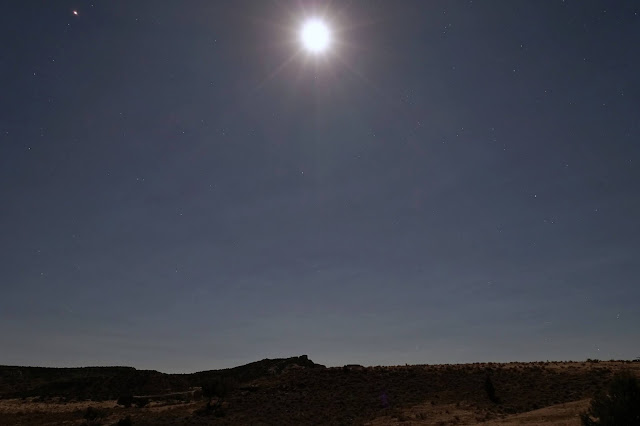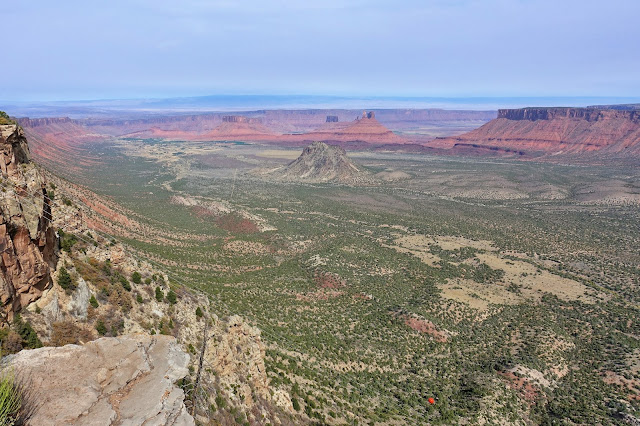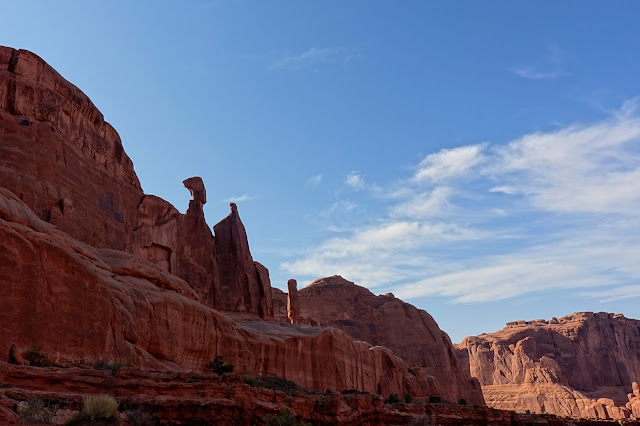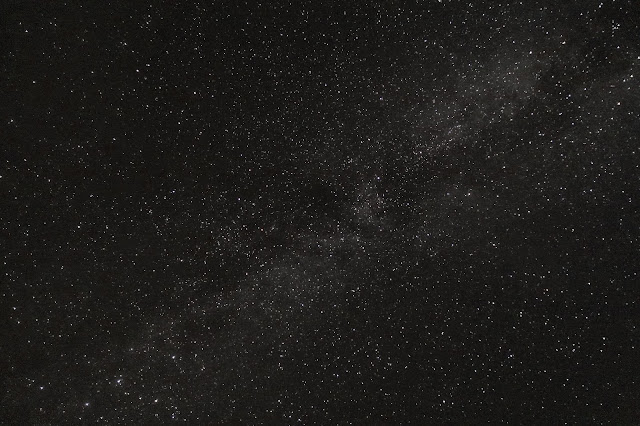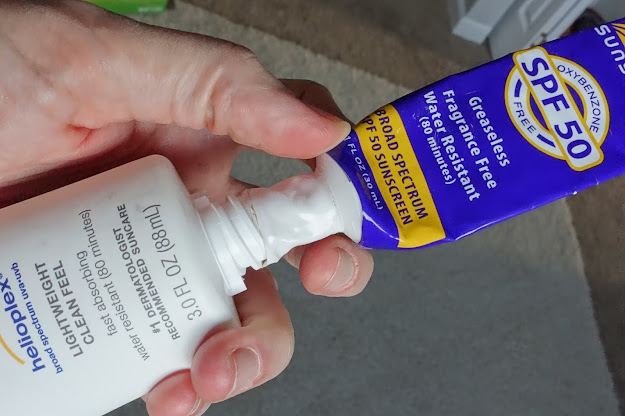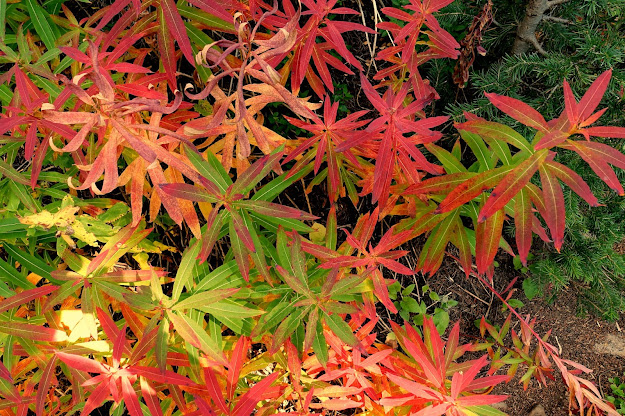I have been to Moab something like eight times now, but always with company -- geology classes, friends, significant others. Since I enjoy doing things by myself, a solo trip was nothing bad, but it was a long way for me to drive alone. It would also be my first time in a long time going out in the fall; usually when I had visited, it had been springtime. Now that I was quite familiar with the area I was curious to see if it would look very different and if the leaves would be changing.
I left Wednesday night after work. The setting sun eerily lit up the smoke from the forest fires.
I drove about four hours and stopped for the night at a free campground in the middle of nowhere. Most of the other sites were occupied and everyone was asleep. A beautiful full moon was overhead. It was light enough to read by, and it seemed warm enough to sleep under the stars. After I set up my pad and sleeping bag on top of the picnic table I went for a walk in the moonlight.
I walked carefully, trying not to trip on the uneven road. I took many pictures of the sky but there were hardly any stars, because the sky was smoky and the moon was so bright. Finally, around midnight, I got into my sleeping bag on top of the picnic table.
I couldn't sleep. It was too cold. I don't know why. When I gave up and got into my car 2 hours later, the outside temperature readout said it was 55. I have a 15 degree sleeping bag. This is a mystery of camping. There have been nights I've been toasty warm and woken up to see the thermometer at 20 degrees, and nights I've frozen even though it was purportedly 55. I think a lot about what causes this. Factors such as wind, air moisture, ground surface, what's above you, clothing, how much energy you expended that day, and how many calories you ate are all factors in how warm you will feel. But I just can't explain what happened that night.
Even shut in my car I was too cold to sleep. I only slept a few hours, and then I slept through my alarm, which I tend to do if I fall asleep shortly before it goes off. This was a problem because I wanted to get into Moab early so I could find a campsite, since they fill up quite early on weekends.
Before I left the highway I stopped at this place to get gas.
I did not get any exotic jerky. I almost didn't get any gas, because I couldn't get the pumps to work. There was no sign of life in the shop. This made me nervous because I had barely enough to get to Moab and there aren't very many gas stations in the Utah desert. But at last I found a pump that was working.
It was warm and summery out. I made my way to my favorite campground and settled on a site that had a nice place to put up a hammock between two juniper trees. I have recently started writing fiction again and am determined to write for two hours a day, every day, no excuses. The fact that I was vacationing would be an excuse, so I had to write. I discovered that if I hung my hammock high enough it made a fine standing desk and so I settled in to write under the juniper trees.
Two families with trucks and RVs arrived at the two sites next to me and began unloading thirteen dirt bikes. They proceeded to rev the dirt bikes, do loops in front of the sites, and ride around the campground loop all afternoon, while running the RV generators to boot. It was insanely loud.
I know we all have our own way of enjoying the outdoors. I happen to think RVing seems fun. I am not going to judge people for wanting a little comfort. But some people just do not seem to notice noise. It doesn't register, doesn't affect them, and it certainly doesn't seem to occur to them that it might be troubling someone else who went camping to get away from noise. They seemed like a nice family. They spoke nicely to each other -- or, rather, shouted over the motors -- unlike the father in a nearby campsite one year who outright degraded and mocked his little daughter. These children (who had their own child-sized dirt bikes) even got along with each other. They just loved their motors.
After a few hours I gave up and went for a hike. I've done the lovely Grandstaff Trail a few times, but never in the evening, so I gave it a go.
It was pretty nice, but also noisy, since several families with yelling and rock-throwing children were hiking at the same time. I mean, if your kids have to yell and throw rocks, I guess nature is probably the ideal place to do it.
It was dark when I got back and I felt like having something other than canned food, so I put in an order to a local Thai place for green curry. When I got there there were a bunch of people in line, and a 45-minute wait to eat, so I felt very smug waltzing in and picking up my food. I ate it at my picnic table in the dark, with a book, which is one of the best ways to eat green curry.
The moon rose and it was very bright again, so I climbed up on the sandstone behind my site and went walking in the moonlight. This campground is my favorite campground because of the beautiful yellow-pink sandstone "hills" and fins that are everywhere. Most of them are easy to climb up onto and you can get a great view -- of the city, the cliffs, the canyons, or the mountains, depending where you are.
This is just a view of my campground loop.
The La Sal mountains in the distance, hazy from smoke
When I went to bed the moon shone through the juniper branches and into my tent. After 10pm it was finally quiet (at least until some of my neighbors roared in on their dirtbikes at midnight), and I stayed up later and later just to enjoy it, because it was the first peace and quiet I'd had since getting settled and it was blissful.
The next morning, I drove somewhat randomly up the road of the rec area the campground is situated in. I've been camping here for years but never drove all that far because the road surface gets fairly uneven. But this time I kept going. The road went up and up. Eventually I found this.
I was on the Porcupine Rim. The view was better than stunning. It was vast and colorful and very deep; I got butterflies as I looked over the edge, all the way down to the valley floor. This is Castle Valley. Much of the Moab area is underlain by salt from old marine deposits, on top of which the sand that now forms that red sandstone was deposited. In this place, it seems, water got into the earth and washed away some of the underlying salt, causing the sandstone layers above it to collapse. The knob in the middle, however, is granite, from a body of magma that intruded into the rocks above it and then cooled.
I hiked down the rim until I found a nice place to set up my office.
The weather was very fine, a little hot at first but then cooler as the day got cloudier. I worked on my story. I didn't realize just how busy the trail I'd come out on would be -- every few minutes more mountain bikers came by, and about half of them made some comment about my setup. It was very positive.
"Nice office."
"That is the coolest thing I've ever seen."
"That is like the definition of working remotely."
That kept a smile on my face. I could tell they were all very envious. They really wanted to be slaving at a hammock computer, not doing a long downhill run next to gorgeous views. But the most amusing thing was their comments to their friends after they'd passed me. Here is a sample:
"Was that a hammock for her laptop?"
"Yeah! That laptop was so comfortable!"
"Nice, work from home!"
"That's not work from home."
"Is this the library section?"
After I finished my two hours I let the hammock down a bit and actually lay in it and read, then packed everything up and went for a hike down the trail. I didn't go too far because I didn't want to get back to camp too late. The sun, when it wasn't behind the clouds now, was already making longer shadows.
However, after I had turned around and followed the trail back to its intersection with the road, I began to wonder whether I might get a view of the La Sal mountains if I just kept following it east. So I did. And I did eventually get to a view of the mountains, after about an hour. I have a terrible disease that requires me to see what's around the next bend, no matter how many other bends I've already come around.
And here are the mountains. Much closer than they were in my moonlit picture from the night before!
It was a lovely, colorful view, all the little bushes in autumn colors and the red and pink of the rocks exposed in the anticline, and the green of the junipers and grasses. And then I turned around and went back, unhappy about how far I was from the car.
That night, once again, I stayed up too late. It was the same story: only after 10pm did it start to get quiet in the campground, and I cherished the quiet. I always like to talk a walk around the campground loop before I go to bed, and I did so, but I also wandered across the road to the parking lot for the bike trail. And then I wandered onto the bike trail. I had never been on this trail. It climbed up onto the slickrock, and to my delight I saw that it was marked with white dashes that showed clearly in the moonlight. So I kept walking. It was warm up on the rocks. The landscape was just beautiful under the moon, flowing rolls of smooth rock looking just like frozen ocean swells, everything in shades of silver and grey. I enjoyed being all alone and was only a little bit spooked at the idea that a mountain lion might jump out from behind some rocky eminence and grab me.
I hated to turn back, but I was very tired and should not be staying out this late if I wanted to go hiking in the morning. On my way back I heard voices. They were coming from somewhere out in the swells of rock, away from the road, away from the trail. There was no light. It sounded like two women and they were talking and laughing and laughing out there in the dark. I supposed they were drunk or high but they seemed to be having an even better time than I was.
The next day, I went to Canyonlands National Park. I stopped to use the vault toilets at the visitor's center.
This was new. The last time I'd been here, there'd been just the toilet, and a sign that looked like this:
Now, looking at the above sign, you might be thinking, what kind of a nutcase would stand on a toilet to go to the bathroom? But think about it. If you grew up in a culture where everybody just squatted over a hole to go, you'd probably be horrified at the idea of having to put your bare butt down on a seat that literally thousands, perhaps hundreds of thousands, of people's butts had already touched. (I'm not even going to get into the international traveler's horror that Americans use only paper to wipe themselves with, without any water at all.) So the existence of that part of sign was understandable. Still no real way to defend the "using the floor" part, but anyway, this place gets a lot of international visitors, so I was pleased to see they'd installed squat toilets. I did not use one.
Now, here is the Shafer Trail, which is actually a road that goes down into the canyon of the Colorado River. Would you like to drive on this road?
In fact it seemed to be quite a bit smoother than the road I had driven to the Porcupine Rim the day before and I think my Prius would have had a fine time. I was tempted to go down it but there was a big sign at the start and I'm guessing it said four-wheel-drive vehicles only.
By this time I have done all of the famous trails in Moab and most of the not-so-famous ones too. One that I hadn't done was the Neck Spring Trail. Mainly because it looked very boring on the map. Guess what?
Rabbit, beetle, and tarantula tracks?
It was very boring. A hot, dry slog under the desert sun. However, it had a rock feature that I took a deep interest in.
It was the highlight of the trail for me. I don't know why it's not advertised in the brochure.
View of the park road from the trail
That evening I went on another hike that was new to me, a little trail not far from the campsite. It was a lovely place from which to take in the sunset, though the sun sank into a haze of smoke and became very weak during the last half-hour.
The smoke made the sun a brilliant, unnatural magenta.
The next day, I went to Arches National Park to hike the Devil's Garden Primitive Loop. Arches has a couple of these primitive trails, in which the trail is not improved or clearly marked and requires some route-finding. I'm sometimes surprised that such trails still exist in national parks, considering our lawsuit-riddled times, but they do. And they're great fun.
On the drive to the trailhead
It was nice that there weren't that many people on the trail. I hiked for an hour then stopped to take a photo of a cairn.
I decided that where I was was actually a nice place to sit and do some brainstorming in my journal. I climbed partway up a rock fin to where there was a natural bench, and began to write. A group came by on the trail, and I took half-conscious note of the fact that a man was clearing some stones off the slickrock. Before he disappeared from sight, I heard a woman confronting him about destroying the cairns.
"They're graffiti. They're made by hikers," he said.
"No, the park service makes them so people know where to go. You're going to get people lost."
"I read that they're graffiti."
The truth is, I had read something to that effect as well. As pictures of aesthetically pleasing cairns invade Instagram, more and more people are noticing, and photographing, and then making these little piles of rocks, and other people are
starting to have a problem with it. These people include conservationists, national park employees, and op-ed writers. I am a devout proponent of unspoiled wilderness, but I still think hiker-made cairns are cute. I don't think people make them in order to "leave their mark," but to feel a sense of participation and connection with others who have left cairns, and to make a kind of art that is exceedingly ephemeral. Most cairns composed on a whim during a hike don't last very long at all before they topple. Compare that to spray-painting a cliff or carving one's initials into an aspen, and the practice seems positively charming.
As for the idea that wilderness should lack all trace of man, well, we're going to need to take out the trails themselves if that's the case. I'm all right with a few rocks being shifted.
And as for the thought that random cairns will lead people off-course... I know that sometimes they will, at least for a little bit. But, as I was finding out, hikers don't need any help getting off-course.
My view, with people
I wrote. People came by. Largely, people came by and glanced around, perhaps tried to mount or slide down some rocks, then turned around and went back, or wandered off in a random direction. Nobody noticed me. I began to call out asking if people needed a hint, whenever they were clearly clueless. Many people took my hints. One man in a helmet with a GoPro on top said, "No, I'm good," and proceeded to climb most of the way up a giant pile of bouldery rubble and sheer cliffy faces.
Almost no one stayed on the path. People wandered off seemingly randomly, or kept going straight when the path turned, or saw some footprints in the distance and made for them despite that the place where they were standing had many times more footprints than where they were headed. I had never seen anything quite this bad before--but then, I had never sat down by a primitive trail and simply watched people come through. By this action my mind was opened to the disconcerting idea that hikers have no idea what they're doing.
You can see the trail in the picture above, or the one below. It's the lighter strip, a whitish trace worn into the red slickrock. It's fairly easy to see in person. Except not to them, somehow. For me, the witness, it was a bit like watching colorblind men trying to find the number 5 that stands out bright red in a field of green, which to them is invisible.
It's not that I never lose my way. But typically I only go a few steps before I realize the substrate beneath my feet has changed -- where before the sand was hardpacked, now it's soft; or now there's lichen, where before, the rock was scraped smooth. It seems now that such discernments involve some sense that 95% of hikers have yet to develop.
I began to help them more. Call out to people sooner. And then, when I had written my two hours' worth, I got down and rebuilt the cairns the other man had destroyed. Because they were clearly needed.
This was a story about a teachable moment, me being the learner. But I also want to say that it was some of the most fun I've ever had on a hike. The fun was in listening to people as they coached others in their group over obstacles, helped each other, talked themselves into things. I watched one woman give up and decide to turn around a couple of times before she finally made it up the steep part. And then, another older couple made it through, and I heard her say to her partner, "I'm proud of us." It was a blast. But after two hours of it I decided I should probably finish my hike.
Private Arch
Sandstone fins
Double O Arch
Hiker on a fin
Partition Arch
Hiking in the age of COVID
Pine Tree Arch
By this point in my trip I was really craving some fresh food--I hadn't brought a cooler, because bringing canned and dried foods is so much simpler--so I stopped at a market on the way back to the campsite. Unfortunately, though it said "Market" in the name, it was more of a convenience store. I wasn't seeing anything inside that looked appealing. Finally, at the checkout counter, where they sometimes have bananas and apples, I found something: local-grown tomatoes. I got a tomato.
I was quite tired by the time I got to camp, but I still struggled up onto the sandstone to watch the sun set. There were flowers. I was surprised at how much like summer, even like spring, it still was here -- grass still green, streams at full flow, plenty of flowers.
A new neighbor had arrived at the campsite next to mine and she approached as I was having my tomato for dinner. We ended up sitting and talking for quite a while. Her name was Jen and it turned out that she was also a geologist, out having a solo adventure, and she'd chosen this campground on a whim. We talked about places we'd been around the west and about backpacking. Later, we went out and walked the bike trail on the slickrock under nothing but stars. Even with the lack of moon and the dimming of the starlight due to all the smoke in the air, the trail could still be seen without a headlamp.
I went to sleep before the moon rose. On my last day, I hung about the campsite for hours, reading and writing. It was past checkout time but no one came to kick me out. It was Monday and the campground was finally quiet.
Finally in the late afternoon I went back to Arches and did some shorter trails.
Lizard tracks
The Windows Primitive Trail was just lovely and far too short. I stepped off the beaten path and followed the cairns around behind the arches, leaving the hordes of sunset-photo-seekers behind. At one point I stopped to take some photos myself and realized that it was almost perfectly silent. No voices, no insects, no cars, no planes, no wind even. It's too rarely I get to experience that, to the point that the sensation is almost otherwordly. Everything seems much more present.
I still hadn't had dinner, so I went to a picnic area a short drive off the main road and ate another tomato I'd picked up, plus some crackers and almonds. When I was done I packed up the food, put the back seats down and set up my bed. I didn't want to get in and drive the hour and half to where I'd be sleeping that night. For the first time on the trip, not only was the moon absent but the smoky haze had thinned enough that the stars were giving a real show.
For about half an hour I stood under the stars, looking and taking photos. It wasn't too chilly yet. It was a little spooky, though -- I was alone in a place I'd seen for the first time in the half-light just an hour before. There could be mountain lions sneaking up on me as I stood there. Though, to tell the truth, the thing I worried about most was that a ranger would come by and think I intended to spend the night there. Hard to argue when you have a bed set up in the back of your car.
It was too beautiful, and I didn't want to leave. But I did.
I drove through the dark for an hour and a half to the free campground. As when I'd come in five days before, it was filled with campers already asleep. Since the latrine had been quite smelly last time I was there, I chose a site far from it. Then I looked at the latrine, not wanting to walk the distance I'd just created in order to go to the bathroom. And it was dark, after all, so I just squatted next to my car and peed there.
And again, just as when I'd camped here five nights before, my alarm failed to wake me in the morning. I can't think of any reason why. As far as I know, there's no magical interference waves a car creates that jam the circuits of alarm clocks. I still had a four-hour drive back to Denver and I was going to be very late for work.
As I walked to the bathroom I realized that I was very close to another campsite. A campsite where about eight people were sleeping under the stars, no tent to shield them from the view of the sky during the night. Or from me peeing right next to my car seven hours before. I wondered if anyone had seen me. In the end, I was hard-pressed to care. I will probably never see any of those people again in my life.
It was a long, tired drive back home, and then I had a full day of work. But it had been worth it, to see that sky. I was already missing Moab by the time I got home. But it's only seven more months until the warm weather returns, and I can go back.


